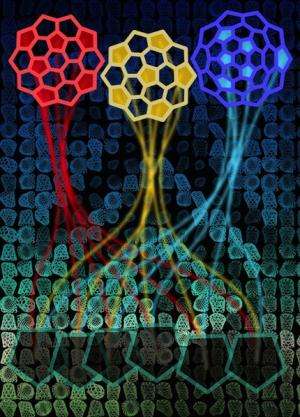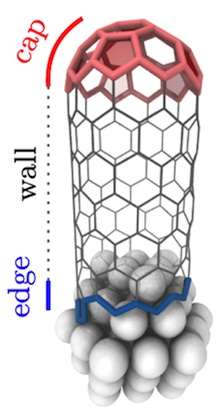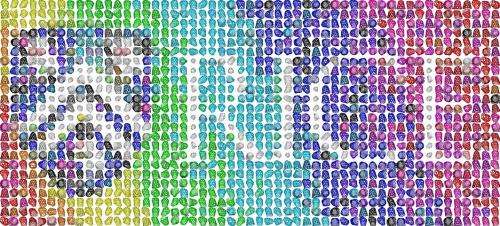Caps not the culprit in nanotube chirality

(Phys.org) —A single-walled carbon nanotube grows from the round cap down, so it's logical to think the cap's formation determines what follows. But according to researchers at Rice University, that's not entirely so.
Theoretical physicist Boris Yakobson and his Rice colleagues found through exhaustive analysis that those who wish to control the chirality of nanotubes – the characteristic that determines their electrical properties – would be wise to look at other aspects of their growth.
In the study by Yakobson, research scientist Evgeni Penev and postdoctoral researcher Vasilli Artyukhov that was published recently by the American Chemical Society journal ACS Nano, the Rice researchers found that the elastic energy landscapes involved in cap formation are not strong enough to dictate the nanotube's chirality.
To get a clear picture of how caps are related to nanotube chirality, the Rice group embarked upon a detailed, two-year census of the 4,500 possible cap formations for nanotubes of just two diameters, 0.8 and 1 nanometer, across 21 chiralities.
The cap of every nanotube has six pentagons—none of which may touch each other—among an array of hexagons, Penev said. They pull the cap and force it to curve, but their positions are not always the same from cap to cap.
But because a given chirality can have hundreds of possible caps, the determining factor for chirality must lie elsewhere, the researchers found. "The contribution of the cap is the elastic curvature energy, and then you just forget it," Penev said.

"There are different factors that may be in play," Yakobson said. "One is the energy portion dictated by the catalyst; another one may be the energy of the caps per se. So to get the big picture, we address the energy of the caps and basically rule it out as a factor in determining chirality."
A nanotube is an atom-thick sheet of carbon atoms arranged in hexagons and rolled into a tube. Chirality refers to the hexagons' orientation, and that angle controls how well the nanotube will conduct electricity.
A perfect conducting metallic nanotube would have the atoms arranged in "armchairs," so-called because cutting the nanotube in half would make the top look like a series of wells with atoms for armrests. Turn the hexagons 30 degrees, though, will make a semiconducting "zigzag" nanotube. Nanotubes can be one or the other, or the chiral angle can be anything in between, with a shifting range of electrical properties.

Getting control of these properties has been a struggle. Ideally, scientists could grow the specific kinds of nanotubes they need for an application, but in reality, they grow as a random assortment that must then be separated with a centrifuge or by other means.
Yakobson suspects the answer lies in tuning the interaction between the catalyst and the nanotube edge. "This study showed the energy involved in configuring the cap is reasonably flat," he said. "That's important to know because it allows us to continue to work on other factors."
More information: "Extensive Energy Landscape Sampling of Nanotube End-Caps Reveals No Chiral-Angle Bias for Their Nucleation." Evgeni S. Penev, Vasilii I. Artyukhov, and Boris I. Yakobson ACS Nano. DOI: 10.1021/nn406462e
Journal information: ACS Nano
Provided by Rice University



















